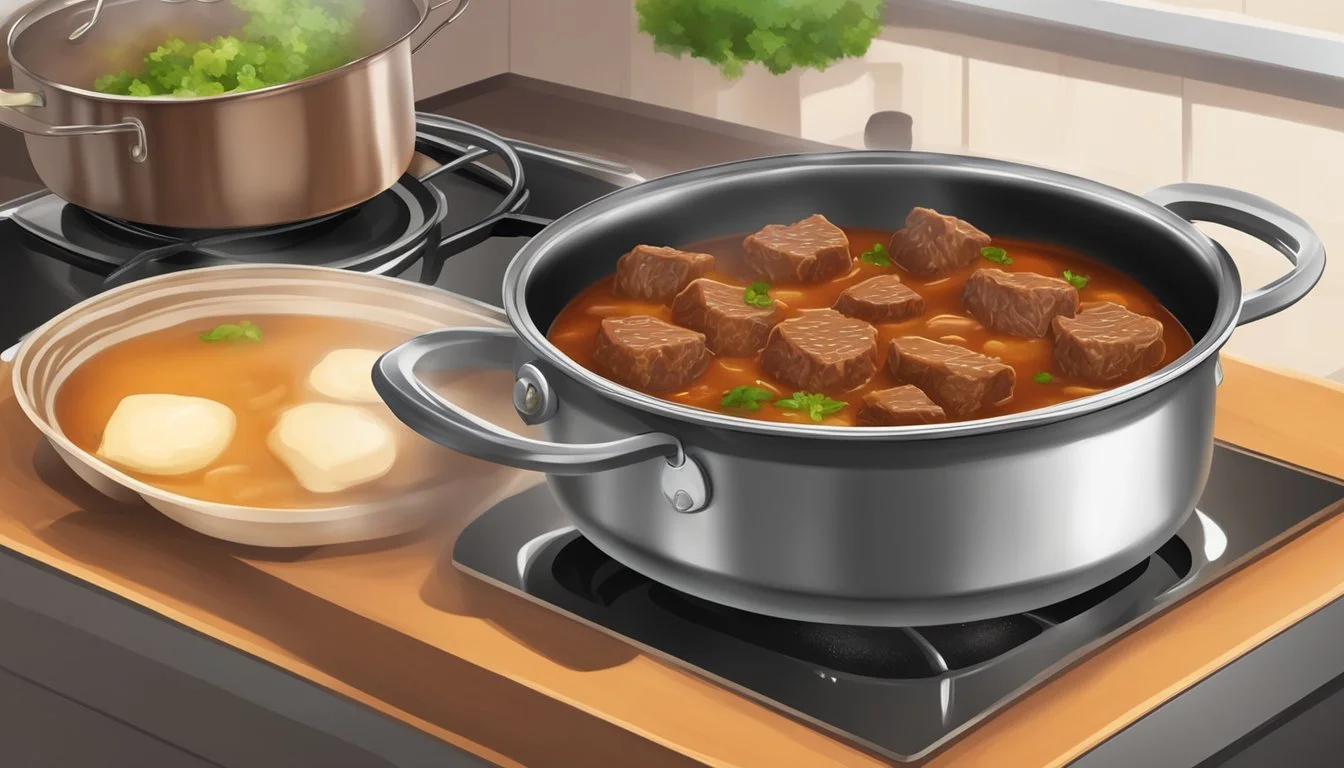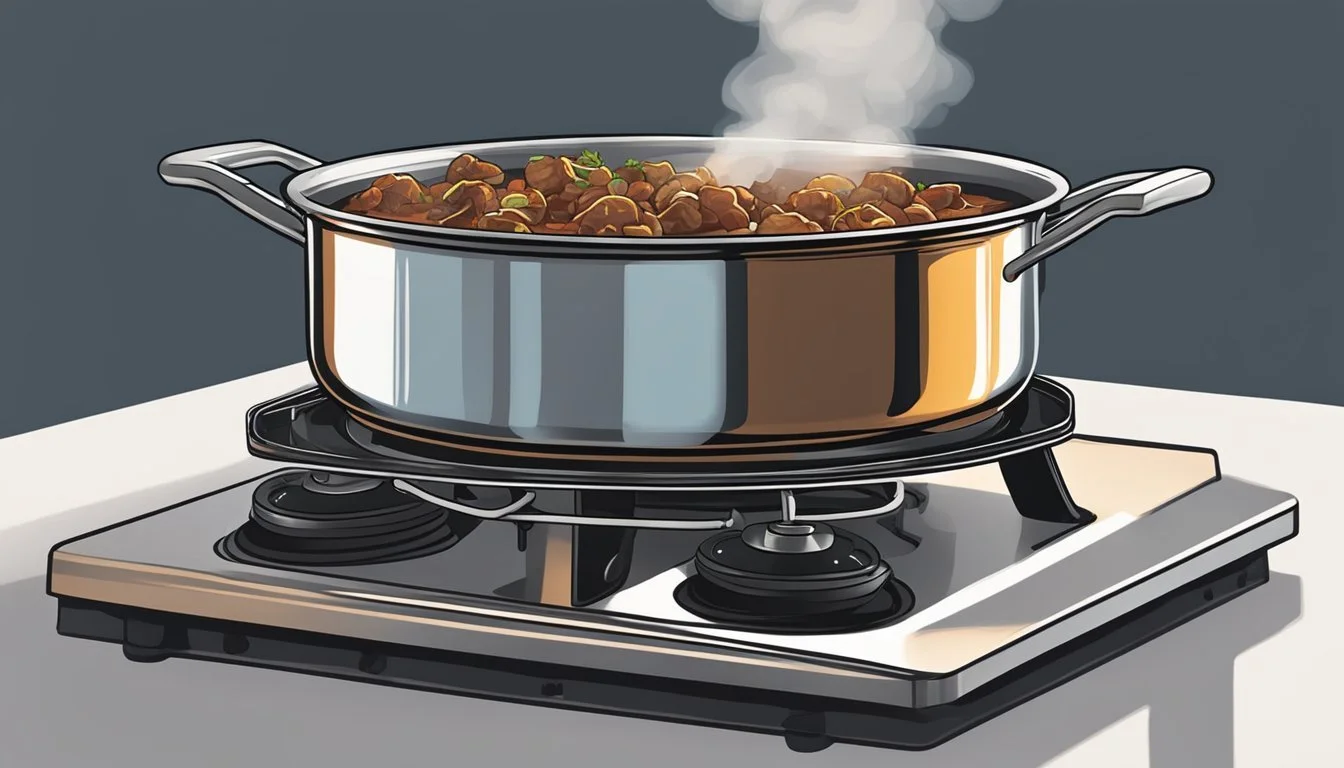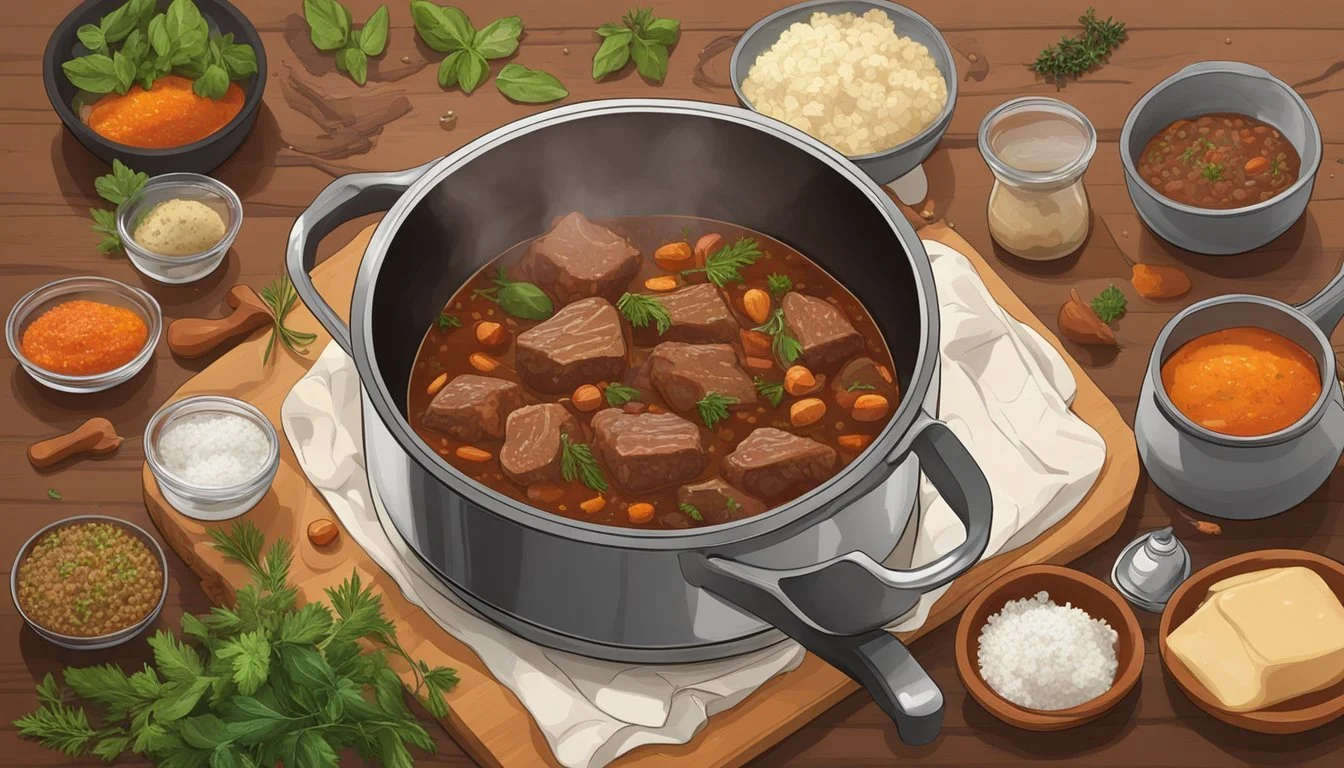Best Way to Reheat Beef Goulash
Ensuring Tender Meat and Rich Sauce
Reheating beef goulash presents a unique set of challenges to preserve the tenderness of the meat and the richness of the sauce. Goulash, a hearty stew known for its deep flavors and comforting qualities, requires careful reheating to maintain its integrity. One must approach the task with methods that do not just warm the dish but also enhance its existing flavors.
The oven is a preferred method for warming goulash evenly while keeping its moisture sealed. By covering the goulash with a lid or aluminum foil and setting the temperature at a moderate 325°F (163°C), the dish can gently reheat to retain its moisture and avoid flavor loss. On the stovetop, gently simmering the goulash over a low heat while stirring frequently can avoid overheating, which is crucial in keeping the meat soft and sauce from separating.
These techniques honor the dish's complexity, slowly warming the goulash without jeopardizing the texture of the beef or the savory balance of its sauce. By adding a small amount of water or beef stock if necessary, one can ensure that the goulash remains a flavorful and inviting meal, almost as good as when it was first prepared.
Understanding Goulash
Goulash, a Hungarian stew known for its tender meat and rich sauce, is deeply rooted in tradition and distinct flavors. This section explores the dish’s background, essential components, and the characteristic tastes and textures it offers.
History and Origin of Goulash
Goulash has its origins in the 9th century as a dish prepared by Hungarian shepherds. Derived from the Hungarian word "gulyás," which literally means "herdsman," the meal began as a simple, hearty stew made by cattle herdsmen and stockmen. Over time, it evolved into a national dish symbolic of Hungarian culture.
Key Ingredients in Goulash
The traditional recipe for Hungarian goulash includes:
Beef: A primary ingredient, often chuck or shank cut into cubes.
Onions: Essential for developing the base flavor.
Garlic: Adds depth to the dish.
Paprika: The quintessential spice, providing color and a sweet pepper flavor.
Carrots and potatoes: Common vegetables included for texture and heartiness.
Typical Goulash Flavors and Textures
Goulash is notable for its bold flavors and hearty textures. Hungarian goulash showcases a distinctive taste profile characterized by the warmth of paprika, which ranges from sweet to smoky, and the richness of slowly simmered beef. The stew typically features a thick, velvety sauce enveloping tender chunks of meat, producing a comforting and satisfying dish.
Food Safety and Storage
Proper food safety and storage are crucial for maintaining the taste and quality of leftover goulash, and it's important to handle the dish correctly to prevent foodborne illness. Below are essential guidelines to ensure that your goulash remains safe to eat and delicious when reheated.
Best Practices for Storing Leftover Goulash
Leftover goulash should be stored in the fridge within two hours of cooking to prevent bacterial growth. It is best kept in airtight containers to maintain its quality and prevent it from absorbing odors from other foods. Here's a concise checklist:
Cool Down: Allow the goulash to cool to room temperature for no longer than two hours before refrigerating.
Portioning: Divide the goulash into smaller portions to cool it faster and for easier reheating later.
Airtight Containers: Transfer the goulash into airtight containers or resealable bags.
Labeling: Label the containers with the date to keep track of how long it's been stored.
Refrigeration: Place the goulash in the fridge, where it should be consumed within 3 to 4 days for the best quality and safety.
Freezing and Defrosting Goulash
For long-term storage, freezing goulash is an effective method. Here's how to freeze and defrost it properly:
Preparation: Ensure the goulash has cooled completely before freezing.
Containers: Use freezer-safe airtight containers or heavy-duty freezer bags.
Portions: Freeze in portions you'll likely consume, this prevents thawing more than needed.
Labeling: Clearly label with the freezing date; goulash can be frozen for up to 3 months while retaining its quality.
Defrosting: Thaw frozen goulash in the fridge overnight. Avoid defrosting at room temperature.
Always ensure to reheat the goulash till it reaches an internal temperature of 165°F (74°C), as measured with a food thermometer, to make sure it is safe to consume.
Initial Cooking Tips to Improve Reheating
Proper initial preparation of beef goulash plays a critical role in ensuring that the meat remains tender and the sauce retains its richness when reheated. Attention to meat selection, browning techniques, and the simmering process can enhance both the initial meal and the reheating experience.
Meat Selection and Preparation
Selecting the right cut of beef is essential for tender goulash. Tougher cuts like chuck roast or beef shank benefit from slow cooking methods, making them ideal for goulash. They should be trimmed of excess fat and cut into uniform pieces to ensure even cooking.
Best cuts for goulash: Chuck roast, beef shank.
Preparation tips:
Trim excess fat.
Cut into uniform pieces, roughly 1 inch in size.
Sautéing and Browning Methods
Before simmering, sautéing onions in oil until they're translucent enhances the flavor foundation of the goulash. Browning the beef is a pivotal step; it should be done in small batches to avoid steaming the meat. Searing the beef at a high temperature locks in juices and creates a flavorful crust that endures through reheating.
Sauté onions: Use a medium heat until translucent.
Browning beef:
Sear in small batches.
High heat for a short duration, aiming for a rich brown crust.
Combining Ingredients for Optimal Simmering
After sautéing and searing, combine the beef with other ingredients, including a flavorful liquid such as beef broth or red wine, and simmer gently. The simmering process allows flavors to meld together and the meat to become tender, which is crucial for reheating without losing quality. Avoid boiling the goulash; a low and slow simmer will yield the best results.
Simmering guidelines:
Combine sautéed onions, seared beef, and additional ingredients like tomatoes, spices, and a quality liquid.
Simmer on low heat; avoid boiling to maintain tenderness and flavor.
Reheating Techniques for Goulash
When reheating beef goulash, it is crucial to maintain the tenderness of the meat and the richness of the sauce. Selecting the right reheating method is vital to achieve this.
Oven Reheating Method
One can reheat goulash in a preheated oven set at 325°F (163°C). The goulash should be placed in an oven-safe dish and covered tightly with a lid or aluminum foil to preserve moisture. Typically, it should be heated for 20-25 minutes, until it has warmed thoroughly.
Stovetop Reheating Method
Using a pot on the stovetop allows for greater control over the reheating process. The goulash should be placed in the pot on medium heat. If the goulash appears too thick, adding water or broth can prevent it from drying out or burning while ensuring even heat distribution.
Slow Cooker Reheating Tips
Reheating goulash in a slow cooker is a gentle method, perfect for preserving its texture and flavors. Set the slow cooker to a low heat setting and allow the goulash to warm slowly, which can take a couple of hours depending on the amount. Keeping the lid on will help in maintaining moisture.
Microwave Reheating: Pros and Cons
While microwaving is the quickest reheating method, it may not be the best for keeping the goulash's integrity intact. If using a microwave, one should heat the goulash in intervals of 2-3 minutes on medium-high, stirring between each interval, and let it stand for a minute afterwards. This method can unevenly heat the dish and may slightly alter the texture.
Preserving Taste and Texture
The goal of reheating goulash is to maintain the integrity of the tender meat and ensure that the hearty sauce retains its rich flavors and texture. Here's how to achieve that:
Maintaining Tender Meat Throughout Reheating
To keep the beef in goulash tender, it is crucial to use gentle heat. Reheating slowly and not overcooking is key to preserving the meat's tenderness.
Oven Method: Preheat the oven to a moderate temperature, around 325°F (163°C), and place the goulash in an oven-safe dish. Cover the dish with a lid or aluminum foil to trap moisture and heat evenly, and reheat for 20-30 minutes.
Microwave Method: For a quick option, reheating in the microwave with medium-high heat in 2-3 minute intervals, stirring in between, helps to distribute the heat and maintain tenderness. Adding a splash of broth can help keep the moisture levels consistent.
Ensuring a Rich and Hearty Sauce
The sauce is the soul of goulash, and it's essential to retain its richness and consistency.
Add Liquids Thoughtfully: If the sauce appears too thick, slowly stir in a little broth. For cream-based sauces, a touch of cream or sour cream can be added to revive the original texture and flavor.
Stir Regularly: Stirring the sauce during the reheating process helps to mix in the added liquids and ensures even heating, preventing any one area from becoming too hot and potentially breaking down the sauce's texture.
By following these tips, the goulash's tender meat and hearty sauce can be restored to their best state, closely resembling the meal when it was first prepared.
Additional Ingredients and Toppings
Adding fresh ingredients can revitalize leftover goulash, while creative toppings offer new textures and flavors to enhance the dish.
Enhancing Goulash with Fresh Ingredients
Parsley: A sprinkle of fresh parsley not only adds a hint of color but also provides a fresh, herby flavor that complements the richness of goulash.
Vegetables: Incorporating additional vegetables such as chopped carrots, peppers, and onions can contribute both nutrition and a more complex taste profile.
Carrots: Add a sweet note and additional texture. Dice them uniformly for even cooking.
Peppers: Choose from a variety, including bell peppers for a mild taste or chili peppers for heat.
Onions: A fundamental element for building flavor, sauté until translucent before mixing into the goulash.
Creative Topping and Side Suggestions
Toppings:
Cheese: Grated cheese melts beautifully on top, adding a creamy and savory dimension.
Chives: Finely chopped chives offer a mild oniony bite which is a perfect finish for the dish.
Sides:
Potatoes: Serve with boiled or mashed potatoes for a hearty side that complements the goulash's robust flavor.
Noodles: A traditional accompaniment, egg noodles make an excellent base for beef goulash.
Bread: A crusty loaf of bread can also serve as an excellent tool for sopping up the rich sauce.
When enhancing the goulash or adding toppings, consider the overall balance of flavors to maintain the harmony of the dish.
Exploring Goulash Variations
Goulash, a stew of meat and vegetables seasoned with paprika and other spices, has undergone various adaptions. Traditional Hungarian Goulash and its American counterpart, though sharing a common name, embody distinct characteristics in terms of ingredients and preparation.
American Versus Hungarian Goulash
American Goulash:
Meat: Typically uses ground beef for a quicker, more accessible version.
Vegetables: Incorporates bell peppers and tomatoes, lending a more tomato-sauce-based flavor.
Consistency: Often has a thicker consistency and may incorporate pasta, making it a hearty, all-in-one meal.
Hungarian Goulash:
Meat: Prefers chunks of beef, which are slow-cooked to tender perfection.
Vegetables: Focuses on fewer vegetables, highlighting the meat and the rich paprika sauce.
Consistency: More soup-like, with a sauce that is rich in both flavor and heritage, often served with potatoes or dumplings.
Incorporating Different Meats and Vegetables
Hungarian Goulash allows for variations in meat, with some versions using pork or lamb, while the richness of the sauce remains a staple. The American version can also adapt to different meats, but more often it's the vegetables that vary - some recipes may add corn, peas, or other available vegetables, altering the overall taste and texture. Regardless of the twist, the essence of goulash lies in the balance of well-seasoned meat with the sauce's richness.
Final Thoughts
When it comes to reheating beef goulash, one's approach can greatly affect the tenderness of the meat and the richness of the sauce. Utilizing techniques that protect these crucial elements ensures that the dish maintains its original flavors and textures.
Firstly, the oven method is commendable for its uniform warmth. One should preheat the oven to 325°F, cover the goulash to keep moisture in, and heat it for approximately 20-25 minutes.
For those seeking a quicker alternative, the microwave can be utilized effectively. They should add a small amount of water to counteract any dryness, microwave on medium-high in short bursts, and stir in intervals. Allowing the goulash to stand post-heating further distributes the heat.
This guide confidently leads readers through reheating beef goulash in a manner that is clear and knowledgeable. It offers a comprehensive understanding, falling into a category of culinary advice that prioritizes the preservation of a meal's quality.
It is also worth noting that proper storage is a crucial step in ensuring leftover goulash remains delectable upon reheating. To minimize flavor loss, one should not refrigerate the dish once it has been reheated.
Lastly, they should remember that each reheating method might slightly vary depending on the specific goulash recipe and its ingredients. Nonetheless, by following these clear instructions, they can be confident in serving a reheated goulash that resonates with the care and richness of its first serving.







